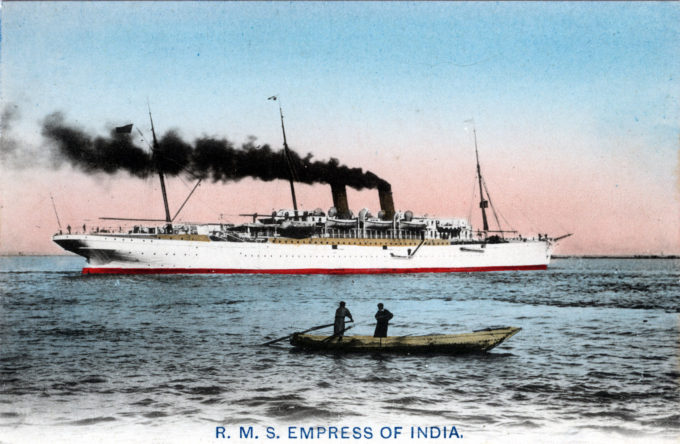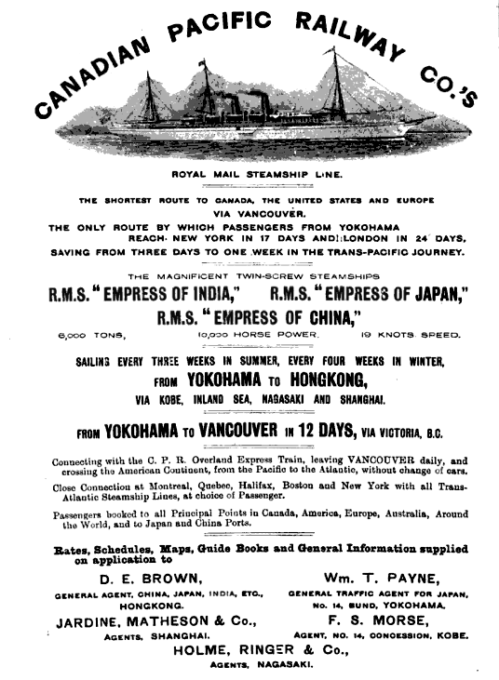“The three Empresses became synonymous with speed, and could make the crossing from Yokohama to Race Rocks, British Columbia, in ten days, 13 hours. Each was distinguished by its own figurehead – a sleek figurehead of Her Majesty Queen Victoria graced the Empress of India.
“Each of the ships took their maiden voyages from Britain to Vancouver via the Suez Canal and, to cut costs, carried passengers, the whole trip costing $600 – it would be the first world cruises. Under the command of Captain O.P. Marshall, the Empress of India departed Liverpool on February 8, 1891, and sailed via Gibraltar, Marseilles, Naples, the Suez Canal (where every passenger disembarked to see the Pyramids), Colombo (where the crew played cricket), Singapore (where four waterspouts were seen), and across the Pacific (during which a battle was witnessed between a whale and a killer whale).
“On April 28, a gun was fired at Mission Point, Vancouver, announcing the arrival of the Empress and, as the ship rounded Brockton Point, the waiting municipal band struck up a tune.
“… The Empress of India was also the first Canadian Pacific ship to carry British royalty. On October 1, 1901, the Duke and Duchess of York (later King George V and Queen Mary) visited British Columbia and crossed on the Empress from Vancouver to Victoria.”
– Sailing Seven Seas: A History of the Canadian Pacific Line, by Peter Pigott, 2010
See also:
R.M.S. Empress of Japan, c. 1910
“In 1889, the Canadian Pacific Railway signed a ten year transpacific mail contract with the British government. That contract called for Canadian Pacific to deliver mail from Halifax to Vancouver by rail, and then to Japan and China by ship, reaching Hong Kong in 684 hours from April to November and 732 hours the rest of the year.
“… Fulfillment of the contract required three ships, built to the Admiralty’s specifications for armed merchant cruisers, capable of 16 knots for regular service, and 17.5 knots in emergencies. Canadian Pacific ordered three ships – Empress of India, Empress of Japan, and Empress of China – to meet the mail contract requirements. All three were built by Naval Construction & Armament Co. of Barrow. These were the first vessels in the Pacific to have twin propellers with reciprocating engines. The Empress of India was designed to provide accommodation for 770 passengers – 120 first-class, 50 second-class and 600 steerage, with steerage sometimes given over to extra cargo.
“The keel was laid in 1890. She was launched on 30 August 1890 by Lady Louise Egerton, sister of Lord Harrington. The 5,905-ton vessel had a length of 455.6 feet, and her beam was 51.2 feet. The graceful white-painted, clipper-bowed ship had two buff-colored funnels with a band of black paint at the top, three lightweight schooner-type masts, and an average speed of 16-knots.
“The Empress of India left Liverpool on 8 February 1891 on her maiden voyage via Suez to Hong Kong and Vancouver. Thereafter, she regularly sailed back and forth along the Hong Kong – Shanghai – Nagasaki – Kobe – Yokohama – Vancouver route. In the early days of wireless telegraphy, the call sign established for the Empress of India was ‘MPI’.
“Much of what would have been construed as ordinary, even unremarkable during this period was an inextricable part of the ship’s history. In the conventional course of trans-Pacific traffic, the ship was sometimes held in quarantine, as when it was discovered that a passenger from Hong Kong to Kobe showed signs of smallpox, and the vessel was held in Yokohama port until the incubation period for the disease had passed.
“The vessel was reported sold on 19 December 1914, to the Maharajah of Gwalior. The former Empress was re-fitted as a hospital ship for Indian troops. On 19 January 1915, the ship was renamed Loyalty. In March 1919, she was sold to The Scindia Steam Navigation Company Ltd. Company in Bombay (now Mumbai). In February 1923, the ship was sold for scrapping at Bombay.”
– Wikipedia



